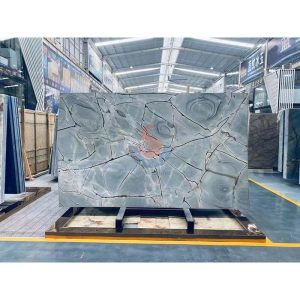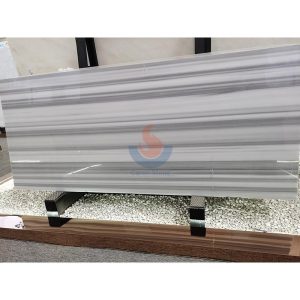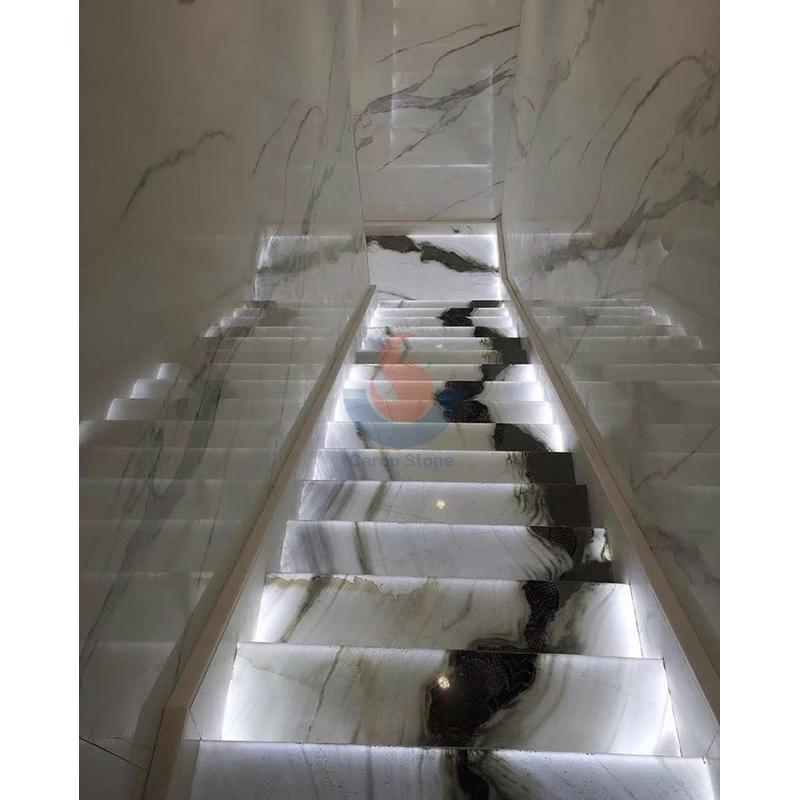Marble, with its unparalleled beauty and unique texture, is widely used in architectural decoration. Marble can always give a building, whether it is a modern home or an old Greek temple, a great vibe. However, while appreciating marble, we often overlook an issue that cannot be ignored: its weight. Marble weight in architectural design influences not only construction difficulty but also directly related to the stability and safety of the building construction. You may ask, does a beautiful marble wall or floor really bring so much pressure to the building? Let’s explore the actual impact of the weight of marble on the building structure and see how this beautiful and heavy “stone” changes the architectural design.

Blue Roma Impression Marble
The source of marble weight: a heavy gift from nature
Marble’s dense material architecture is the reason it is heavy. Mostly made of calcite (calcium carbonate), marble has developed an incredibly thick crystalline shape over millions of years of geological action. This density gives marble extremely high compressive strength in load-bearing, but because of this, its weight is particularly prominent compared to other decorative materials.
Usually two cm thick, one square meter of marble slab weights between fifty and sixty kilogram. If it is thicker marble, say a 3 cm thick slab, its weight will be between 80 and 90 kg. This is merely one square meter’s weight. Imagine the weight the building’s construction will carry if marble covers the whole floor or wall.
The impact of marble weight on building structure
1. Challenges of structural design
First seen in the design stage is how marble weight affects building construction. Architects and structural engineers must fully consider the impact of marble weight on the overall structure when designing, especially in high-rise buildings and large public facilities. If the weight of marble is ignored, it may cause insufficient bearing capacity of the foundation and frame of the building, causing structural problems and even safety hazards.
2. Increased construction difficulty
Marble’s weight not only challenges the design but also makes the building process more challenging. Construction workers need to pay special attention to the weight of marble when laying marble floors or installing marble walls, which often requires the use of special equipment and tools to carry and install. In addition, heavy materials may also increase safety risks on the construction site, requiring more stringent safety measures.
3. Impact on the life of buildings
In the long run, the weight of marble may also have an impact on the life of buildings. Since marble is a relatively hard material, when it interacts with the building structure for a long time, it may cause stress concentration in certain parts of the building, thereby accelerating the aging or deformation of the material. Marble flooring especially show this stress concentration, which may cause ground settlement, cracks, and even structural damage.
4. Challenges of maintenance and repair
Marble is a natural stone, hence its weight presents significant difficulties for maintenance and repairs. If cracks or damage appear on the marble surface, the difficulty and cost of repair will be much higher than other lighter materials. How to safely remove and replace marble slabs during repair is also a considerable problem, especially in high-rise buildings or inaccessible areas.
“Transformation” of marble weight: the integration of lightweight stone and modern architecture
With the development of construction technology, the emergence of lightweight marble slabs and marble composites has provided architects with new options. These materials keep marble’s beautiful qualities while significantly lightening weight. Marble composite slabs, for instance, are a layer of lightweight substrate laid under the surface of real marble that not only preserves marble’s texture and color but also lessens the total weight. In addition to being more practical for installation and construction, this material lessens building structural pressure, so giving architects more design freedom.
1. Advantages of lightweight materials
The use of lightweight marble composite materials can not only reduce the load on the building, but also reduce the cost of transportation and installation. Furthermore more environmentally beneficial are lightweight materials since they usually demand less natural resources and lower energy usage during building. The emergence of this new material has made marble more widely used in modern architecture, especially in high-rise buildings and large-area decoration.
2. Improved design flexibility
The versatility of architectural design has been much enhanced by the use of lightweight marble products. Marble is more easily used by architects for different designs without regard to weight’s effect on the construction. This has found a new balance between decorativeness and functionality for marble, making architectural design more diverse and personalized.

High quality Marble Polished Marmara Equator White Stone for Toilet Floor
Marble weight does have a significant influence on building structure, hence careful thought is needed everywhere—from design to construction to maintenance. Although the aesthetic value of marble is irreplaceable, its heavy characteristics also bring many challenges. Fortunately, lightweight marble slabs provide us a solution that lets us appreciate the beauty of marble without having to worry too much about its weight thanks to ongoing innovation in building materials. In future architectural designs, how to cleverly balance the weight of marble with the stability of the building structure will continue to be an important topic that architects need to explore in depth.





